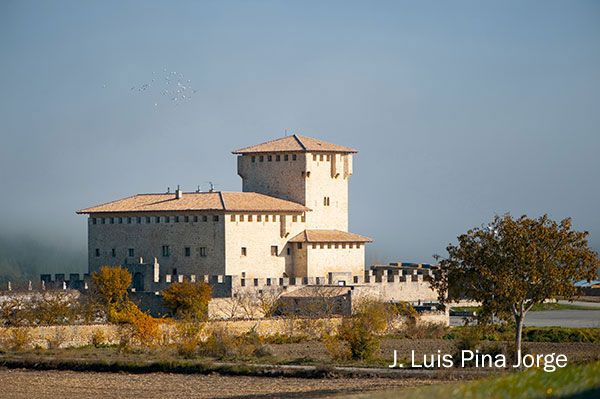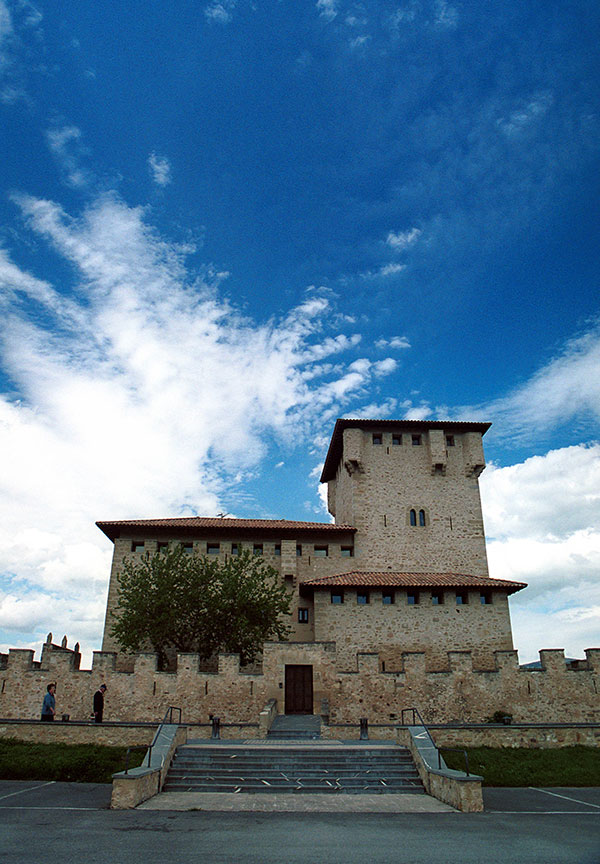The imposing Tower-House of the Varona family is a spectacular example of XIV century military architecture, said to be the best preserved in Alava. It rises up from a plain that enables it to dominate the surrounding land

The building forms a single historical unit which may be split into two parts, namely the Manor House and the Tower, the latter with well-fitting ashlar work .
The building as a whole may be considered as being the best preserved fortified structure in Alava. It has recently been restored .
The tower stands out from one side of the precincts, and is finished off at the angles by prismatic pieces supported by modillions, there being a corbel on the south wall. The roof has four pitches, with eaves covering the crenellated zone .
The Mansion House backs on to the tower on two sides, while the building is surrounded by a crenellated wall and moat filled with water. It has recently been restored and boasts interesting family records .
History tells that it was a Visigoth admiral, Ruy Perez, who ordered the tower to be built around the year 680.
The zone had been abandoned by the Romans, and the Visigoths were engaged in conquering it and staying on in the Valley.
The admiral ordered the tower to be built in a strategic enclave.
It is said that Don Pelayo rested here after the battle of Guadalete (711), and that from here began the Reconquest .
Round about the year 1080, in the times of the Cid, two brothers and a sister were to be found living here. They joined up with Doña Urraca de Castilla’s faction which was at war with the king of Aragón.
María Perez, the sister, was determined to follow her brothers to the conflict, so she dressed in armour and went with them to defend their standard.
After the fight, the troops dispersed and María, finding herself alone as it grew dark, came up against another soldier unsure of where he was. This was Alfonso the Battler. María kept her face covered with her helmet, as the heraldic statue of her that can still be seen in Villanañe shows, and fought against the Aragonese. Although her sword was broken, her bravery was such that she overcame her opponent and took him prisoner. In admiration, the king said to her: "You have fought not as a weak woman but as a strong man and must call yourself and your descendants by the name of Varona. In memory of this deed you shall bear the arms of Aragón".

There is some discussion as to whether the origin of the bars on the Varona coat of arms is a result of the above, or because María Perez was subsequently Don Vela’s wife. The fact that the bars are diagonal, indicating that they have been earned as a trophy, gives weight to the first theory.
The name Rey came to be Rodrigo, and this has been the name given to the first-born male of the family throughout the generations.
The Perez was lost and came to be Varona, which has been kept over the course of time.
The tower as it stands dates from the XIII-XIV century, having been built over the previous one. It has four floors.
The Varonas are one of the few instances of a Spanish noble family living continuously in the same place from the XV century to the present day. As a result, the mansion house has evolved and been modified with the times and the needs of its occupants.
It has recently been restored, and while not yet open to the public it may well be so before too long.
Inside their house, the Varona family has managed to keep details of great interest and historical value.
In the porch, for example, is a strange drawing in the form of a rosette with rounded edges which has the same diameter as the largest bell in the cathedral at Toledo, while the thickness of the outer circle is also the same as this bell. No-one knows who had it made or why the sizes of the Toledo bell were reproduced, although there is no shortage of stories on the subject.
On the upper floors, the series of wallpapers covering the walls of several rooms is of impressive colouring.
These papers, which have been dated back to the XVII-XVIII centuries and are in perfect condition, replaced the tapestries that previously covered the Mansion walls.
The floors in each room also attract attention, whether of wood as in some cases or Manisse porcelain portraying four scenes from Don Quixote in others.
From September 1st to June 30th
Saturdays, Sundays and holidays:: 11:00 - 14:00
JULY & AUGUST
Martes a sábados: 11:00 - 14:00 / 16:00 - 19:00
Tuesday to Saturday: 11:00 - 14:00
Monday: CLOSED
